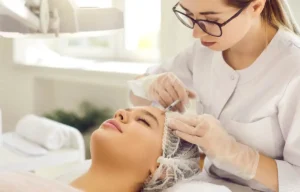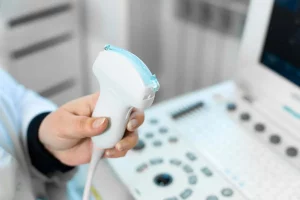
Most people associate the word “aesthetician” with the face, but this job isn’t just about facials. Aspiring aestheticians can also choose to focus on their hands or feet or even specialize in a type of facial treatment like laser hair removal.
But regardless of what you specialize in—or if you don’t specialize—some basic requirements need to be met before you can get certified as an aesthetician. In this article, I’ll talk about how to become a facial aesthetician and some resources for doing so.
Steps to Become an Aesthetician
Talk to an aesthetician about the job.
So, you want to become a facial aesthetician. Well, it’s time to talk with someone who has been in the field for some time and knows what it takes. Find an aesthetician in your area, set up an appointment, and ask them all your questions.
What is a facial aesthetician?
A facial specialist (aesthetician) provides skin care services such as facials, body treatments, and waxing. They also offer makeup application and skin analysis services to determine if products benefit each client’s unique needs.
What does a facial aesthetician do?
Facial aestheticians perform various procedures, including microdermabrasion, chemical peels, light therapy, laser resurfacing treatments, and other corrective measures such as botox injections or dermal fillers, which are used primarily for anti-aging purposes.
They can also be used for acne scars treatment or reducing wrinkles between eyebrows due to constant frowning over the years after becoming parents, etc. So if you’re interested in working with people who have beautiful faces, this may be the right career path for you.
Find a school near you.
At the very least, you want to ensure the school is accredited by the National Accrediting Commission (NAC), which the U.S. Department of Education strictly regulates. But finding a reputable school can be difficult when there are so many options out there.
Here’s how to get started:
- Search for schools in your area online and check their accreditation status on the NAC website. The site lists all accredited schools and locations where you can search for more information about them.
- Ask friends, family members, and co-workers for recommendations on facial aesthetics programs in your area that they’ve attended or heard good things about—this may save you some time investigating schools yourself!
- Contact your local library or community college directly if your budget doesn’t allow for expensive tuition costs at private colleges/universities; they may have lists of available courses that don’t require prerequisites (like high scores on standardized exams).
- You should also contact state boards regarding certification requirements before enrolling in any coursework—they may require proof of completion after graduating high school/postsecondary education program(s).
Check to see if your state’s board approves the program of cosmetology.
The next step is to check whether your state’s board approves the program you’ve chosen for cosmetology. Most states require a certain number of hours or credits and a certain level of education, so be sure to look up this information before enrolling in school.
Some states also require additional licenses or certifications for practicing aesthetics, so make sure you’re aware of what those entail and let them know ahead of time if you’re interested.
Apply to a school and attend classes.
- Visit the school’s website to learn about its admission process, curriculum, and requirements.
- Consider financial aid options, such as loans or grants that are available to you.
Complete your program and pass your final exam.
- You need to complete your program and pass your final exam.
- After completing your program, you can take another test known as the National Certification Examination for Estheticians (NCET).
- Once you have passed this exam, you will be able to get a license from the state where you live that allows you to practice as an esthetician or aesthetician in that state (or country).
Getting certified takes time.
Becoming a facial aesthetic is no easy feat. It takes time and dedication, but it’s well worth it. There are many steps to becoming certified, including getting your certificate of completion from an accredited institution, passing the National Board for Certification in Therapeutic Massage and Bodywork exam, continuing education credits (CECs), insurance requirements, and more.
What is Your Job as a Facial Aesthetician?
Facial aestheticians are experts in the art of skincare and beauty. They recommend treatments to help clients achieve their desired results and maintain healthy skin. If you love interacting with people, have a passion for helping others, and are interested in cosmetology as a career path, then becoming a facial aesthetician might be right for you.
Facial aestheticians are specially trained to perform advanced skincare treatments.
As a facial aesthetician, you’re trained to perform advanced skincare treatments. You can use microdermabrasion and chemical peels to improve your client’s skin health or perform facial waxing and skin analysis. Whether you want to concentrate on hands-on practice (like applying makeup) or take on more administrative duties, such as organizing your clients’ schedules, it’s up to you.
Educating clients on caring for their skin at home.
Facial aesthetician training is a great way to get started in this field. If you are interested in becoming a facialist and want to know what it takes to become one, here are some of the steps needed for this career.
- Take classes at your local community college or beauty school.
- Network with other professionals that work in your areas, such as estheticians and makeup artists.
- Practice on friends and family members until you feel comfortable enough to perform facials professionally.
Facial aestheticians help people feel great about the appearance of their skin.
As a facial aesthetician, you help people feel great about the appearance of their skin. Your goal is to make people look younger, healthier, and more beautiful than before your treatment began. You can do this by removing unwanted blemishes, reducing wrinkles, and making people feel more confident.
Conclusion
If you want to become a facial aesthetician and learn more about the job, we encourage you to talk with an expert in the field. Many beauty schools near you offer programs that teach students how to perform these services at a professional level.
Glo Academy is a new aesthetic training service that provides employees with the necessary knowledge and skills to work in the aesthetics industry. All program sessions will be taught by experienced professionals in the field and are led by state-certified instructors.





